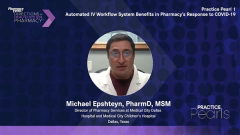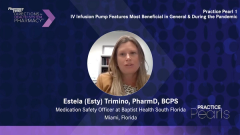
Practice Pearl 1: Automated IV Workflow System Benefits in Pharmacy’s Response to COVID-19
Michael Epshteyn, PharmD, MSM, and Estela Trimino, PharmD, BCPS, share what led to automated IV workflow system use and how it aids in pharmacy’s response to COVID-19.
Episodes in this series

Madeline Camejo, PharmD, MS: Michael, one of the things that I would like to ask you is, what led to the use of your automated workflows, and how did it aid? You previously mentioned endeavors, what were some of the things [Medical City Dallas Hospital] had to figure out quickly, and how were you able to download your medication pumps? What are some of the things you guys had to do quickly?
Michael Epshteyn, PharmD, MSM:That’s a great question, Madeline. Our facility is licensed for 800 beds. It’s a very large hospital with a variety of service lines where we service the NICU [neonatal intensive care unit] premature babies all the way to oncology, stroke, and cardiovascular care. We needed to make sure that barcode technology was optimized. We’ve been using barcode medication scanning for quite a few years and implementing IV [intravenous] workflow technology just made sense. A few things that are useful in that technology, among others, this technology requires the pharmacy personnel to use barcode scanning on medications before they are used for compounding. That’s a safety feature. Also, IV workflow technology allows for image capturing. We could do very quick quality assurance, and if there was ever a recall or a question based on the fact that all of these emergent treatments for COVID-19, at least initially, were emergency use approvals, so there was a chance things would have to be discovered or recalled. So, image scanning and record keeping capability of an IV workflow system are very useful.
One other item that’s not always mentioned but we found to be very useful is that an IV workflow system improves overall efficiency. As I mentioned, we have a wonderful facility that is widely spread out. We have multiple towers, and the logistics are complicated. But because the new automated IV workflow system that we utilized is internet based, I could have a pharmacist working in a different tower yet have fine images of what we are compounding and also have access to the full queue, where you don’t necessarily have to pre-batch items way ahead of time. You could make them on an as-needed, just-in-time basis. And anybody at any location who has access to the system can verify the status. That’s been very helpful, especially considering that when the new COVID-19 treatments first came out, the beyond use dating, or how quickly they expire, was pretty conservative, it was a matter of hours. We didn’t want to have any product wasted, and this automated workflow system helped us to be more efficient and to prevent wasting of any products and know exactly where it’s at within our system.
Madeline Camejo, PharmD, MS: Yes. A lot of good work you guys did, and it’s been a crazy time, an exhausting time for a lot of health care workers. Not just with taking care of the patients but also constant changing of workflow systems that had to be put in place for all these new medications coming in. Esty, I’d like to talk to you about, were you able to generate any reports, or how were you looking at doing your batching for some of these medications as you had to give them throughout the hospitals? And talk to me more about the inventory management. Was that centralized? What was that approach?
Estela (Esty) Trimino, PharmD, BCPS: As far as what we were utilizing, we ran a lot of reports to see what we were using in our ICUs [intensive care units], what we were using in the EDs [emergency departments], what were the most common things we needed. We did have a lot of inventory controls through our supply chain and distribution. What we tried to do is look at these products and optimize our therapies. We were using one type of medication for a paralytic, so we made sure that we had that product available, that we weren’t wasting any of those products. We looked at storage conditions, where we were having or utilizing those medications. We’re a system; all of our hospitals went to the same type of inventory and drugs we were using, so those became the formulary products. We obviously had to adjust order sets to look at that.
Transcript edited for clarity.
Newsletter
Stay informed on drug updates, treatment guidelines, and pharmacy practice trends—subscribe to Pharmacy Times for weekly clinical insights.






















































































































































































































